I don’t live in Moab anymore. It’s been a decade since I packed my bags and slipped south (and then east) to smaller, quieter communities. Last week, after 37 years, I closed out my box at the post office. Box 221 was my last physical connection to Moab. Handing Kyle my key, I felt downright emotional. A lot of mail has flowed through there, for better or worse, over the decades and many conversations took place standing in front of it. And I even remember back a couple decades when one of the old county commissioners suggested that for most of us hippie-types in Moab, a post office box was about as close as any of us would get to owning property in Grand County. As incredible as this might sound, I miss that guy and the way Moab felt in those days. And interestingly, after years of real affordable housing in Moab, times when us hippies did buy homes, now most younger, recently-arrived Moabites with modest incomes are once again forced out of the real estate market.
But there I go reminiscing again. Sentiment and nostalgia are frowned upon by many of my more “progressive” friends these days. That surprises me, because there was a time when we were the Romantics and the Dreamers. Still, while I’ve relinquished my last little piece of property in Moab, my PO cubbyhole, my spiritual and emotional connection to Moab is still strong. And it always will be. So I keep an eye on the town and surroundings from a distance, knowing that it’s not really mine anymore. What the new citizens of Moab want it to become may disturb me, but in the end, it’s their community to do with as they please. I threw in the towel long ago; I don’t think I’ve openly complained about the never-ending construction and development of Moab’s suburbs in years. On my rare trips to Moab, I avoid Main Street, seeking out my old friends and neighbors.
But every once in a while, it’s hard to at least keep from offering an opinion. Two familiar issues are making headlines again—massive recreation upgrades and massive energy extraction. What no one seems interested in admitting is the connection these two economic engines have to each other. So let me leap into the breach.
Last month I was back in town and read in the Moab Sun News that a proposed multi-million dollar Moab Transit Hub and Elevated River Bikeway is about to start construction. I had heard very little about this plan, though I’d caught a snippet of information several years ago, in a Times-Independent article by Ron Georg. He made references to a planned “bike path” along the Colorado River from Route 128’s junction with US 191, to Negro Bill Canyon, three miles upstream. It all sounded quite benign were it not for one disturbing sentence. Georg wrote, “The next phase of the state Route 128 bike path, which would take riders east, is the most complicated, as it will require a path to be cantilevered out over the Colorado River.”
Cantilevered? What the hell, I thought. I stewed over the mere idea of it for a few minutes, but ultimately decided it belonged in the same category as other outlandish Utah-grown fantasies like cold fusion, Book Cliffs Highways and toxic waste incinerators. Eventually I forgot about it. In the three years that have passed since, I never heard the project mentioned once until late July, when the announcement appeared in the local papers. It’s a done deal and by the time this story goes online, construction will have already commenced.
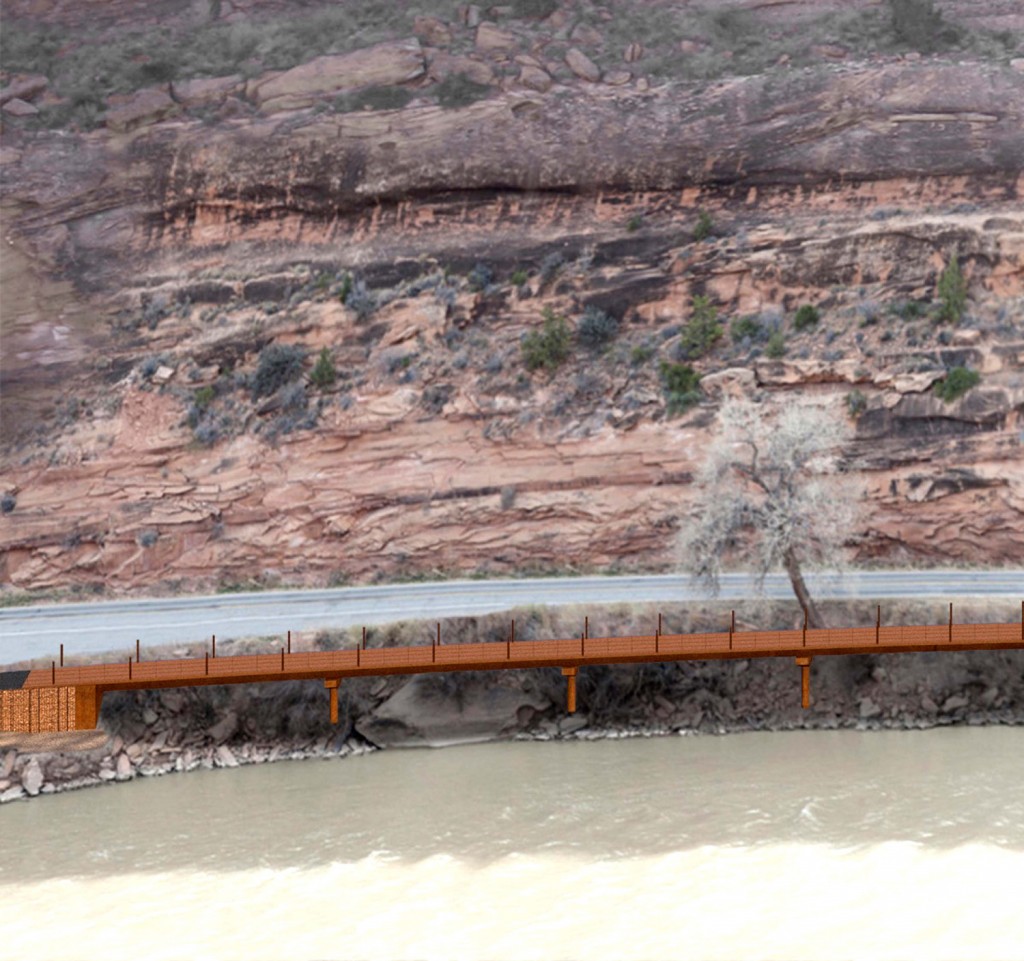
An architect’s concept drawing of a small portion of the bikeway. For comparison, note the “Leaning Tree” again in this image.
(courtesy Horrocks Engineering)
In the Moab Sun News, Kristin Johnson Millis wrote, “The plan is not a simple one. The elevated concrete paths are built like bridges with girders and decks. Holes will need to be drilled for piers. A crane, which will take up both lanes of traffic, is needed to place the girders and decks.” To get those piers and girders and decks in place, traffic along 128 will be regularly disrupted. Millis reported, “Engineers have been working with Castle Valley residents to find solutions to a construction project that will affect daily commutes into town. Contractors are allowed to shut down to one lane between 5:30 a.m. to 11:30 p.m. Traffic delays should be 15 minutes or less for commuters.”
Promoters of the bikeway have insisted that its main purpose is ‘safety.” Clashes between bicyclists and autos have been numerous and intense over the years. But efforts to gather data on bike-related accidents that involved serious injury or death have been unsuccessful. So far, while the conflicts between bikes and cars have almost become the stuff of legend, it’s been difficult to accept the notion that a multi-million dollar bikeway is a more reasonable solution than a strictly enforced 25 mph speed limit.
More telling is Councilman Chris Baird’s recent presentation to Governor Herbert. In a Moab Times-Independent story,

Grand County Councilman Chris Baird. Photo via.
Baird said, ““For a long time we were the mecca for mountain biking, but about five years ago, we started seeing newspaper and magazine articles about Moab going stale…So we initiated a process with our last (resource management plan) with the [Bureau of Land Management] to create 150 miles of new single-track… By the time everything comes to fruit, we’ll have an asset almost entirely grant funded worth almost $21 million.”
Clearly, the Grand Plan of the Moab Transit Hub and Elevated Bikeway is to jumpstart a perceived sagging tourist economy. It’s been like this since Moab chose to put all its chips into an amenities/tourist economy two decades ago. Safety is a selling point but not the driving force behind it.
With a multi-million dollar budget and year-long delays, clearly this is one of the biggest recreation infrastructure projects ever initiated in Grand County (not counting road expansions). But who knew? There was some vague knowledge among the Moabites I spoke to of a “bike path.” But elevated bikeway? Piers? Girders? CANTILEVERS? The mention drew blank stares. Finally, I sent a message via facebook to County Councilman Baird.
Baird advised me that, “There are several sections where the path will be an elevated bridge, although the pylons will only be in water during a very high water year. So, yes, the elevated sections are between the road and the river. Other parts of the path will be more of an elevated retaining wall, and, others, where there is land, will just be next to the road…I acted as manager on this project for about 1.5 years and haven’t received any environmental complaints. The project has now passed all hurdles (except for construction) and so is now in the hands of the community development department. Castle Valley is concerned about the imposition on traffic while under construction, and some conservatives have offered criticism regarding the $ spent, which is almost entirely federal grants.”
I asked about BLM and whether environmental assessments to consider the impacts from the construction had been completed. Baird told me, “Yes, many EAs, in fact, as it was federal money the environmental scrutiny was even more strict than usual. The trail goes across state, federal, private, sovereign, and county land. In fact, a great deal of time and energy was put into routing the trail around one cottonwood tree.”

With all the work that had been put into the project, it still baffled me why so few Moabites seemed tuned into it. I suggested that apathy might account for a lack of interest in or awareness of the project: “Even 20 years ago we used to joke about Moab Apathy but it seems to have outdone itself.” Mr. Baird took issue with that comment and offered an expanded view of non-motorized versus motorized recreation:
“The Moabites you know must not read the newspaper,” he said, “ not, at least for the last 4 years. Apathy? Takes a lot of work to do these things, but, I assume you’re talking about the apathy of the nay-sayers. The nay-sayers are those who think riding a bike instead of driving everywhere is a mighty trivial thing to spend money on, especially if it takes money away from roads for cars….I suppose, for one reason or another – probably that you aren’t from the west and have always wanted to earn your red-neck merit badge – that you don’t ride bicycles around, perhaps your version of enjoyment is to fly to the other side of the earth’s hemisphere, and drive around there for a while, before then flying back and driving around here for a while, ok… and taking a short hike here and there. Is an alternative transportation system developed specifically for non-motorized users so bad? I’m sure your preference is that everyone just go away, but, barring that, would you prefer that they burned gasoline, or powerbars?”*
I contacted Katie Stevens at the Moab BLM. I was interested in following up on Councilman Baird’s assertion that “many EA’s” had been conducted in preparation for the project. Ms. Stevens replied by email, “Two EAs were done on this project – one was completed in 1999 and the other in 2004. There were no public comments on either EA.”
The 2004 EA describes the proposed bikeway in some detail:
“…the bike lane would be slightly separated from the highway both vertically and horizontally for approximately 36% of project length. In these narrow sections, special construction methods would involve highway guardrail and concrete curbing and riverside handrails and be supported by gabion and key block retaining wall or similar structures. For approximately 12% of project length, the bike lane would be separated from the highway by more than 5 horizontal feet and require no vertical separation, guardrail, or other special construction…The shared use bike lane would be built in stages. The entire project would require approximately 5,300 feet of gabion retaining wall (or similar structure), 6,300 feet of guardrail, 5,700 feet of handrail, 5,800 feet of concrete curbing, 300 feet of key block retaining wall (or similar structure), and construction of 80 foot long and 65 long bridges across drainages existing at the mouths of Negro Bill Canyon and Ice Box (Short) Canyon.”
The BLM advertised the public comment period and even extended it in May 2004, but they received no comments. Whether it was Moab Apathy or the idea that such a huge project would never get funded is anybody’s guess. As Baird noted, he “didn’t receive environmental complaints” from environmental organizations. And finally, for the many Moab/Grand County citizens who don’t ride bicycles, the project didn’t appear to be something that they’d be personally interested in.
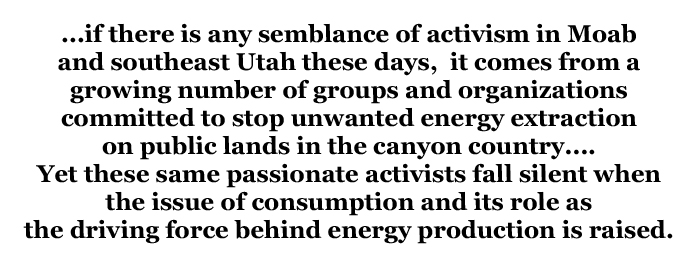 So while the idea of a “bike path” was never an issue for most residents, eight years after the public comment period came and went, some will be surprised to see what’s coming. Whether you’re a bike rider or not, the changes along those first three miles of river, upstream from US 191, will be significant.
So while the idea of a “bike path” was never an issue for most residents, eight years after the public comment period came and went, some will be surprised to see what’s coming. Whether you’re a bike rider or not, the changes along those first three miles of river, upstream from US 191, will be significant.
Now, as construction is about to begin, a more accurate description of the proposal is available. According to Baird, “If the main project and 2 added alternatives are built the total elevated section of the trail will be 2,322’ or .44 of a mile…The total trail, if phase 3 is constructed (currently an added alternative in the bid), will be about 2 3/4 mile long, including the Goose Island part which is already built. There will however, still remain about a .5 mile gap just before Negro Bill. Also, if the added alternatives are feasible, we plan an 88’ bridge over the outlet of Negro Bill.”
Also, according to Councilman Baird, “there will be 2217 additional feet of retaining wall.” The total length of the elevated bikeway and retaining wall—4539 feet. Baird previously stated that, “Only a fraction of the pathway will be elevated.” And that’s true, if somewhat misleading. About a third of the 2 3/4 miles will be elevated. The entire project, including the “Moab Transit Hub” with its bicycle underpass that allows bikers to cross the river road without having to worry about vehicular traffic and a renovated “Lions park” will cost $9 million. According to the Moab Sun News, “To create the transit hub 50,000 cubic yards of rock will be removed from the hillside south of SR 128. There will be 43 parking spaces for people to park their car and get on their bike. There will be a 200-foot loading and unloading area for shuttle vehicles and tour operators. There will be restrooms. And, maybe most importantly, there will be a 60-foot-long pedestrian and bike underpass to provide safe passage under State Route 128 from the transit hub to the Lions Park Trail Hub.”
Kim Schappert, of Moab Trails Alliance and the driving force behind the project said in 2010, “It’s all going to be a showpiece.” Whether a “showpiece” is what most Moabites wanted for the river road is unclear.

But it doesn’t matter. Construction begins soon (if it hasn’t already) and besides, as one local environmentalist explained to me, “We have bigger issues here than bike paths…we have tar sands. nuke plants. These are the big battles.” And indeed, if there is any semblance of activism in Moab and southeast Utah these days, it comes from a growing number of groups and organizations committed to stop unwanted energy extraction on public lands in the canyon country. In addition to long established environmental organizations like SUWA and the Grand Canyon Trust, with their multi-million dollar budgets and array of lawyers, a more grassroots collection of start-ups are making themselves heard as well.
“Peaceful Uprising,” “No Fracking in Moab,” “Before it starts—Keep tar sand and oil shale out of the USA,” CanyonCountry Rising Tide,” “Occupy Moab, “ ”Canyonlands Watershed Council,” Occupy Moab in Solidarity,” “Utah Tar Sands Resistance,” “No Nukes in Green River”….the opposition to the extractive industry in southeast Utah is formidable. Some of the groups are volunteer organizations that have facebook pages and a lot of enthusiasm. Others are attempting to become non-profit organizations, with paid staffs and budgets. In most cases they find an “umbrella non-profit” from which to establish their 501 C(3) credentials.
The threat to southeast Utah from energy development is real. A proposed nuclear power plant at Green River refuses to go away, a proposed tar sand test site north of the Book Cliffs moves closer to fruition, and a recent announcement by the BLM that it plans to lease large tracts of public land south of Moab for oil and gas development that could include fracking have all made headlines in the last six months. On the ground protests and a fervent facebook activism keeps opponents of energy development a force to be reckoned with.
Yet these same passionate activists fall silent when the issue of consumption and its role as the driving force behind energy production is raised. It was my favorite conservationist and writer, Wendell Berry, who wrote:
“…this is what is wrong with the conservation movement. It has a clear conscience….To the conservation movement, it is only production that causes environmental degradation; the consumption that supports the production is rarely acknowledged to be at fault. The ideal of the run-of-the-mill conservationist is to impose restraints upon production without limiting consumption or burdening the consciences of consumers.”
I’ve never seen so many well-intentioned environmentalists run so rapidly or fall so silent when Mr. Berry’s admonition is recited. A community whose economy and existence, by definition, demands the massive consumption of energy just to get the tourists to Moab, needs to at least understand how complicated and layered this issue is.
Let’s follow some non-motorized recreationists as they make their way to Moab and the new Hub/Bikeway. They board a flight in London or New York or Los Angeles or Atlanta and they fly thousands of miles to Salt Lake City, or Denver, or Phoenix, or Las Vegas, where they rent a car or SUV and drive hundreds of miles to stay in one of Moab’s dozens of motels, so they can drive out to the Moab Transit Hub each day and ride their bicycles for ten or twenty miles.
The energy to build the plane, fuel the plane, build the rental car, fuel the rental car, build the motel, power and heat/cool the motel, build the bike and fabricate the plastic parts contained in ALL of these conveyances and structures comes from companies extracting oil from the ground, by whatever means they can think of, to produce petroleum-based products and make a profit. Why are energy companies fracking every remotely conceivable source of oil and gas?
It’s called supply and demand.
I don’t need to be convinced that fracking is bad. It can be a disaster. Where I’m living these days, farmers compete with the oil companies for water, which both industries need to successfully operate. It’s easy to guess which of them is better suited to pay a higher price. My point is that Moab has pursued a tourist/amenities economy that has been supported and embraced by the mainstream environmental community for 20 years. The most powerful “green’ organization for wilderness these days is the outdoor recreation industry and Utah enviros have gone along.
When Moab supports and promotes the construction of a $9 million “Moab Tourist Hub” and a mile-long “elevated bikeway,” and not a single environmental group—not SUWA, not the Grand Canyon Trust, not Living Rivers–offers ANY opposition, it speaks volumes about the total disconnect between “production” and “consumption.” Tourism and Elevated Bikeways and Transit Hubs are not forms of clean, non-motorized recreation. These kinds of tourist amenities and energy extraction are inextricably linked. One leads to the other. Yet environmentalists refuse to consider the unholy bond between them.
Consider this report from the United Nations on the impact of tourism on climate change. “In 2005,” the report states, “ tourism’s contribution to global warming was estimated to contribute between 5% and 14% to the overall warming caused by human emissions of greenhouse.”
More specifically, the report noted, “By 2035, tourism’s contribution to climate change may have grown considerably. A recent scenario…considers different emission pathways, including a ‘business as usual’ projection based on anticipated growth rates in tourist arrivals, as well as distances travelled by various means of transport. These projections indicate that in terms of the number of trips made, global tourism will grow by 179%, while guest nights will grow by 156%. Passenger kilometres travelled will rise by 222%, while CO2 emissions will increase at somewhat lower levels (152%) due to efficiency improvements. The share of aviation-related emissions will grow from 40% in 2005 to 52% by 2035…The development of emissions from tourism and their contribution to global warming is thus in stark contrast to the international community’s climate change mitigation goals for the coming decades.”
In the future, climate change can be addressed in part by pursuing alternative clean energy options. But what we REALLY need is a global re-evaluation of Growth and the insane pursuit of material wealth and the empty gratification it offers us. Or as author Paul Kingsworth calls it, “a civilization……brought down by a rapidly changing climate, a cancerous economic system and the ingoing mass destruction of the non-human world.”
If we are sincere about reducing carbon emissions and want to stop the onslaught of energy production now moving forward on an unprecedented scale, we have to acknowledge these hard truths. This is a cultural issue as much as it is an economic or environmental one. The planet cannot survive this Culture of Consumption. Yet in Moab, where in 2012, the encouragement and promotion of unlimited consumption is now presumed to be the town’s only way of surviving, hard truths are getting harder to come by.
* EDITOR’S NOTE: During the spirited ‘conversation’ that followed, I asked Mr. Baird whether his comments were on the record. He replied, “Yes. In context.” Thus I included the complete paragraph. Now, Mr. Baird has demanded that I reprint the entire 6000+ word facebook message thread, “word-for-word.” While I am not impressed enough with my own rhetoric to think that our lengthy argument was worthy of being printed in full, Councilman Baird still wants it to be available. Therefore, anyone wishing to read the entire transcript can contact The Zephyr after October 6th (Tonya and I will be away from the internet until then celebrating our first wedding anniversary) …JS
Click here to read Part 1 of the PDF version of this article.
Click here to read Part 2 of the PDF version of this article.
Don’t forget the Zephyr Ads! All links are hot!

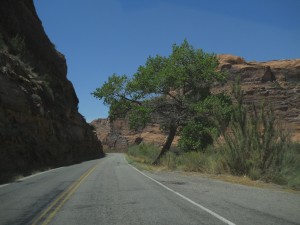

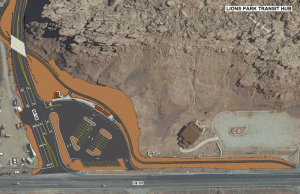
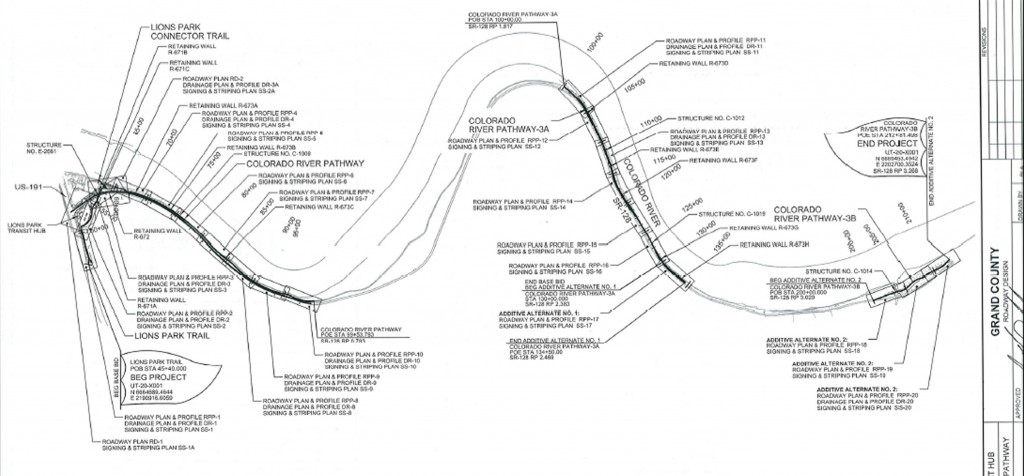
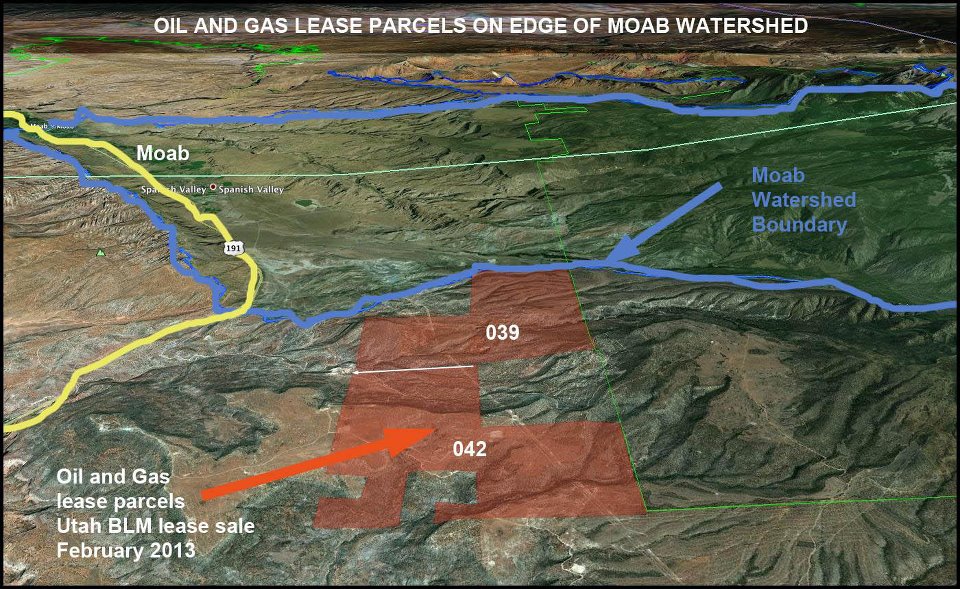
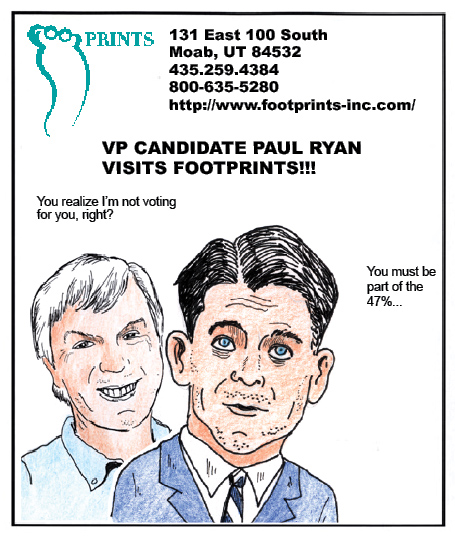
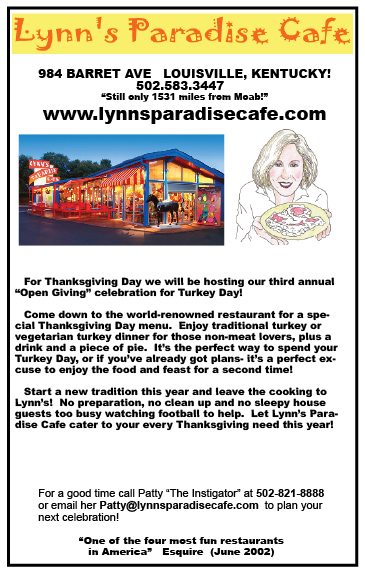


you know, Mr. Stiles, it has NEVER occurred to me: the duality of extraction which is what the CONSUMPTION is all about. You hit the nail linking this duality right amongst the big flat part of the nail.
And that helps me rationalize NOT driving/flying long distances to “recreate.” I can do it usually within 40 or 50 miles of my house. And now, you have me wonder … is driving even that “far” a bad thing?
Good stuff, Mr. S., and good point.
Stiles, get a grip. You ran off the miners, ranchers and farmers and are now dismayed, that this hydra-headed, recreation economy has taken it’s place? I say embrace fracking, it’s honest work that obviously, provides the where with all for the recreation economy. Some people have to extract energy somewhere, to finance Obama’s socialist utopia, let alone this bike path. Windmills, solar and bio-fuels just won’t get it done. It was always thus, carbon to carbon, dust to dust.
thanks Jim,
Consumption for consumption’s sake, much like the idiom about so- called “bagging a 14 teener” in Colorado has had a good run… unfortunately no matter aside… this conspicuous consumption is going to stay w/ us all on the planet as long as the five dollar Starbucks and 4G networks are proffered up to us…
What are your suggestions for reductions in the consumerist’s advantages? How will the negative opinions of the consumers of amenities discount the tenets of the article? Is there a method to reach the resource holders?
Dear Freefarmer: Seems to me that Stiles is one of the few around here who >does< have a grip! Must we simply accept the ruination of everything? Is destruction of the natural world through consumptive demand inevitable? I fear that it is. Why is simply talking about it an invitation to "get a grip"? We need to talk about this, as individuals, communities, a society, as a species. Who gets the petroleum when it becomes so scarce that it costs $100 a gallon? Mitt Romney and his pals, that's who. Allright, enough bitching.
As any old-timer drug and alcohol counselor like me knows, addicts always SWITCH DRUGS – from Oxycontin to Marijuana, for example – before giving them all up. It’s a law of addiction that the false solution always precedes the real one.
Environmentalists in southeastern Utah have fallen into this very pit, switching from big, bad EXTRACTION to cuddly, green recreational CONSUMPTION, while the blindness to the addiction itself – exponential economic growth – remains.
Any sober addict will admit to you that the solution they feared all along was the real one.
Ever so right, yet the younger generation accepts conformism -consumerism without knowing what their conceeding. One young
smart fellow reacted to my complaints of paying to be on public
lands by saying ‘ at least someone can make $ doing it’
What do you say??
Why not do what you’re told “If your not guilty why should you worry?”
…or, to quote Ed Abbey…
‘I think the human race has become a plaque upon this Earth. There are far too many of us making too many demands on one defenseless little planet. Human beings have as much right to be here as any other animal, but we have abused that right by allowing our numbers to grow so great and our appetites to become so gross that we are plundering the earth and destroying most other forms of life; threatening our own survival by greed and stupidity and this insane mania for quantitative growth, for perpetual expansion, the desire for domination over nature and our fellow humans.’
I love Moab. Have been visiting the area for decades. I use to own property there. I wanted to retire in Castle Valley until I read this article. No more. This “cantilevered” bike path is among the dumbest, most assinine ideas I have ever heard. The people who conceived this idea ought to be tarred and feathered. You will ruin the very character and sereneness of one of the most beautiful drives on the planet. You dumb bastards should be ashamed of yourselves. If you were standing in front of me, I would kick you in the gonads. Plain ignorance and greed. I thought environmental-minded people protected our lands. I will never go there again…very sad. Thanks for this article Jim.
to former moab lover, happy that u won’t be in moab again, for yes there are too many tourist here already. am i a fan of pork barrel projects? no. will i use this one? yes! leaving my home by bike, hit bike lane on mill creek drive, slid onto bike path thru town( more pork) catch bike path at denny’s, head to new hub(pork) decide which way to go, over new (pork barrel) ped. bridge or newer(pork) bike path along colorado river. win win situation. the fast decent past arches nat. park will be more adrenaline producing, but will bother mr. stiles more, even though the during the slow accent i will promise to smell the flowers and enjoy the scenery, a famous climber(rock that is) called it feeding the rats, which always made perfect sense to me.
jim, does it bother me that to visit your friends in moab u have to drive from kansas (i call everything east of the front range kansas) instead of moticello or what mpg your car gets? no those are you’re demons, i’ve got my own- need i mention the demapublicans with a clean sweep once again of the recent elections? or my contrbution to SUWA, or going camping in the dodge van instead of the old honda that gets good mpg’s, or that i’m bummed mr. baird is no longer a councilman, doing the right thing? yes the police caught him breaking open matrimony springs so we sorry humans could get water that comes out of the ground. don’t get me wrong i luv your rant but we all have war stories- i moved to breckenridge ,co after high school in 79 check out that nightmare.
and no the enviros did not embrace the tourist economy, did ken slieght embrace the tourist economy by bringing them to the desert,no he did because he loved the place, did abbey bring tourists to the desert with his writing, sure he did because the dirt got into his pores just like it got into yours and mine. good thing this came out before the latest greatest, oh ya a zip line course complete with atv,s to get you there up the old moab cattle trail across from denny’s, yes u can visualize the brochure the smiling faces the outdoor gear wardrobe the rental jeep into the paved parking lot the catered lunch package……BREATH!!!!! do not buy a sniper rifle u couldn’t get enough bullets. there is a factory (in china) where they make an endless supply of these people.
travel light, live light, spread the light, be the light………………
U dumbasses shot down the gondola and approved this? The most beautiful country on ear5h Switzerland has 500 cablecars.
[…] (1) http://www.amazon.com/Brave-New-West-Morphing-Speed/dp/0816524742/ref=sr_1_1?ie=UTF8&qid=1385994115&sr=8-1&keywords=brave+new+west (2) http://www.canyoncountryzephyr.com/2012/10/01/moab-fracking-climate-change-elevated-river-bikeways-b… […]
Stiles always misses the forest for the trees. This bikeway–and the others–is as much about creating a livable community as it is about tourism. To conflate this excellent project with the destructive rape and pillage of the oil and gas industry is disingenuous, or even psychotic.
The fact that Stiles isn’t a biker is screamingly clear in the observation that he finds the bikeway an abomination but has nothing but praise for the “beautiful drive” that is the river road. If there was a rape of nature, it certainly didn’t happen when the County added a beautifully constructed and designed bike lane to an existing road plowed into a beautiful place.
Stiles is a fount of unending negativity. I can’t believe it hasn’t killed him yet. Moab is a better place now that he’s gone.
AN OPEN REPLY TO ‘WHATEVER’
Hello Ms. Whatever,
We always post comments, no matter how personal or vitriolic they get. But…do we know each other? You posted anonymously and I don’t understand the level of your personal animosity.
I’ve made it abundantly clear that Moab is no longer my town and that I reside happily and blissfully elsewhere. I do feel my 30 years in Grand County give me some right to express an opinion, whether you happen to agree or not. Your complaint was more of a personal venting than an intelligent defense of the Elevated Bikeway. It really did seem steeped in…you know…negativity.
The story you so vigorously object to was more, in my opinion, a fact-based analysis of the project and the impacts of tourism on the environment than an emotional rant. It’s hard to believe you read it..or at least all of it.
Finally, I suggest you follow these links. They may be better suited to your preconceived conclusions:
‘OH FOR AN INSUPERABLE MOAB’
http://www.canyoncountryzephyr.com/2013/10/01/oh-for-an-insuperable-moab-by-jim-stiles/
SANITIZING THE TRUTH: How BIKE Magazine Butchered an Honest tale of Moab’s Last 20 Years
http://www.canyoncountryzephyr.com/2013/10/01/sanitizing-the-truth-how-bike-magazine-butchered-an-honest-tale-of-moabs-last-20-years-by-jim-stiles/
We look forward to future comments from you. But next time, show a little courage and include your name. I have a great deal of respect for people who have the integrity and honesty to attach their names to their convictions, whether I agree with them or not..
Cheers…JS
[…] (1) http://www.canyoncountryzephyr.com/2012/10/01/moab-fracking-climate-change-elevated-river-bikeways-b… […]